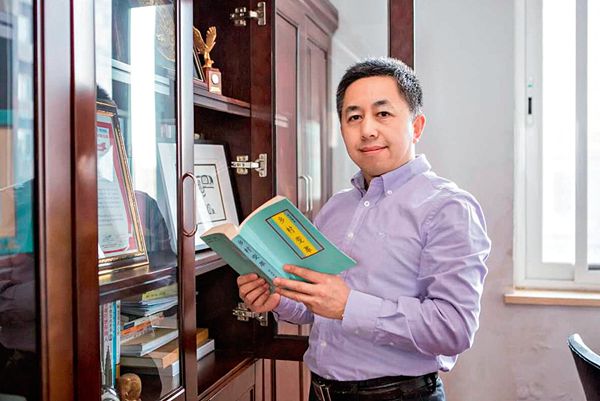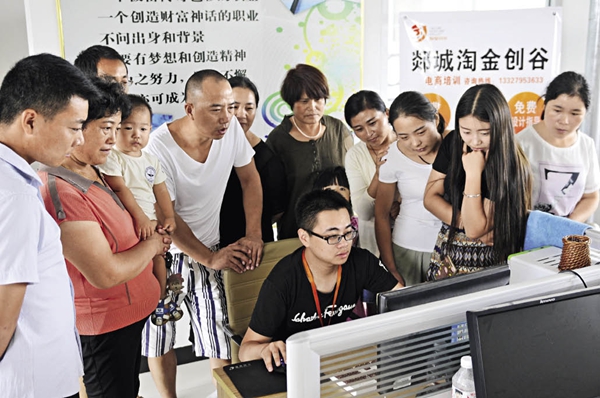By WEI BO


By WEI BO
AS the first nation to achieve the UN Millennium Development Goals, China has made immense contributions to reducing global poverty. The Chinese government is presently bringing into effect targeted poverty alleviation strategy, trying to lift the country’s penurious rural population out of poverty, according to present standards, by 2020. Non-government organizations (NGOs) have long played an important role in promoting public participation in poverty alleviation efforts. In the new period, how will NGOs further mobilize people’s proactive support for the poor? This was the question China Today raised in an exclusive interview with Liu Wenkui, Secretary General of the China Foundation for Poverty Alleviation (CFPA).
Civil Force to Overcome Poverty
China Today (CT): What role do NGOs play in overcoming poverty? What are the characteristics of poverty-relief work?

Liu Wenkui.
Liu Wenkui (Liu): Chinese President Xi Jinping said in his message of congratulations to the Civil Society 20 China 2016 (C20) in July that civil society organizations play an important role in public affairs, as well as in economic and social development. The mobilization and organization of civil power is a main feature of China’s poverty relief, including fixed-point poverty alleviation, poverty relief coordination between eastern and western China, and campaigns in which NGOs and the public participate.
Statistics show that, from 1994 to 2000, NGOs and other social forces raised funds and goods with a value exceeding RMB 50 billion, accounting for 28 percent of total poverty relief funds in China, and 35 percent of the ratio of poverty alleviation contributions. Since the turn of the century, NGOs, encouraged and supported by the government, have made constant innovations and played a significant role in promoting equality in education, better health conditions, and community development. They have also given timely support to humanitarian aid in poverty-stricken areas.
Thirty years of experience has made us aware of the great potential NGOs have for eradicating poverty. First, NGOs offset the shortfalls of government poverty alleviation. In addition to raising more social resources to benefit more poor people, these organizations can also apply their relevant experience to project management, supervision, and assessment. They thus make this work more effective. Second, social organizations can create a wide range of mechanisms, such as funding, multilateral cooperation, participatory decision-making and application, and empowering the poor. Third, the participation of social organizations in global poverty relief activities is conducive to poverty reduction through exchanges among states of experience and cooperation, and jointly studying the problem of poverty on a global scale.
CT: China is now following a targeted poverty alleviation strategy. How will non-profit organizations contribute to national targeted poverty relief efforts?
Liu: There are two layers to targeted poverty alleviation. First, poor people are the target, that is to say, the work must focus on households registered as poor in poverty-stricken areas. This is the most important index. Second, the work evaluates its effectiveness by, after pinpointing the target, determining whether or not the project in question can solve the problem through increasing incomes and thus improving people’s capacity to improve their living conditions. The effect of poverty alleviation work is therefore also a major index.
Public interest organizations should trifurcate their efforts. They must first of all mobilize resources, give play to their strengths, and mobilize cooperative partners. Second, the project design should be geared to poor households in poor areas. Third, research and innovation should lay emphasis on effect, evident in whether or not it can help to increase the incomes of low-income families and improve their capacity to escape poverty. This is how non-profit organizations can best achieve targeted poverty alleviation.
Innovation and Initiation
CT: How can the public be encouraged to take part in charitable works?
Liu: Based on social requirements, public interest organizations should constantly innovate in their calls for greater public participation by launching new projects. If the mechanisms in place fail to mobilize sufficient social forces, new mechanisms, new methods and new channels should be formulated in efforts to establish a platform for social organizations.
In recent years, NGOs have explored ways of involving more people in promoting public welfare, a mindset evident in “Public Advocacy.” Rather than sending money and goods to the poor, Public Advocacy commits to popularizing the concept of public welfare through public fundraising activities, such as the global ice bucket challenge.

A tutor demonstrates online selling skills to villagers from Matou Town in Shandong Province.
Regarding innovative development, the CFPA has also looked into ways of encouraging more people to become involved in public welfare. They include using mobile Internet to set up online donation platforms via WeChat and Alipay, effective new methods, such as charity walks and 24-hour fasts, and drawing on the experience of popular charity models to create forms of poverty alleviation that resonate with the public.
CT: Might some of the public welfare activities you mention, such as the ice bucket challenge and 24-hour fasts, be perceived as superficial, or simply publicity stunts?
Liu: Self-experience can lighten a heavy topic and bring it closer to home. China has a huge number of registered volunteers and voluntary organizations. Judging from previous public welfare advocacy projects, people are becoming more aware of and receptive to charity. This implies the huge potential of public welfare projects. In the past it was traditionally assumed that only celebrities were capable of successful charitable activities. But the advent of Public Advocacy has made it accessible to people from all walks of life.
Seeking Change
CT: Along with the advance of science and technology, Internet Plus is changing everything. What opportunities does it offer for public welfare?
Liu: The progress of Internet technology brings even more possibilities for anti-poverty projects. “Internet Plus poverty alleviation” raises another line of thought on solving the problem – that of promoting economic development in impoverished areas. High transportation costs and scant market experience, which result in products performing badly in market competition, are the biggest problem for farmers in these areas. Luckily, the problem is now solvable. The vital e-commerce poverty relief mode offers new development opportunities in our poverty alleviation work.
The CFPA has put in a lot of effort in the e-commerce poverty relief field. In March 2016, it found that e-business could earn fruit farmers decent incomes in Ya’an, Sichuan Province. Thanks to e-commerce promotion, 50,000-kg of oranges from Ya’an sold out within three hours. This was the CFPA’s first instance of e-commerce poverty relief. Exploring new e-business modes has thus proved successful in practice for public welfare organizations.
CT: Some e-commerce platforms focus on form at the expense of substantial content. What’s your opinion on this?
Liu: The basic function of e-business is to create an online marketing channel free of time and space boundaries. In recent years, the government and responsible enterprises have invested substantially in rural Internet infrastructure, thereby laying good foundations for farm produce e-business. However, how to make farmers benefit from the e-business platform remains a tricky issue. The situation can be ascribed to three bottlenecks: small scale, due to a production mode of scattered households; low quality, resulting from effective constraints; and the absence of long-term agricultural trust. These problems need to be resolved before farmers can benefit from e-commerce. We can now help them dissolve these three bottlenecks by bringing e-commerce poverty relief into effect.
CT: Could you be more specific about how the CAFA can solve these three operational bottlenecks?
Liu: The bottleneck of scale also constitutes one of productivity.
The scale of production from a single household can hardly meet the needs of e-commerce sales. Moreover, according to traditional production modes, a single farmer acts as producer and technician as well as seller. Low efficiency is generally the result of this lack of specialization.
This is why we build cooperatives in rural areas and divide them into several work groups. It solves the problems of production scale and efficiency.
The low-quality bottleneck is also a big impediment to farm produce e-commerce.
Under the traditional market pricing mechanism, prices gradually rise from wholesale to retail. However, the price at which products are purchased from farmers is usually low. To increase their incomes, therefore, farmers must use all means available to lower their costs and raise production. Those most commonly applied are the use of pesticides and chemical fertilizers, the former to reduce labor costs and the latter to boost yield. But low expenditure leads to low quality and consequently lower prices, so forming a vicious circle of food safety problems.
Unless they earn reasonable incomes, it is impossible for farmers to produce high-quality foodstuffs, let alone guarantee consumer rights and safety. To break the low-quality bottleneck, we have formulated a unified quality standard through strict monitoring and also set up a tracing mechanism. For example, now, every fruit crate is marked with the producer’s name. We also cooperate with an international UK inspection organization to ensure that products meet each of the 156 technical indexes necessary to meet the requisite standard. If one work group does not meet this standard, it is removed from our system. If three work groups fail the standard in a cooperative, the entire cooperative is removed. This constitutes an interest-binding system. Since news travels fast by word of mouth in rural areas, no one would risk imperiling the benefits of the entire village. This guarantees product quality.
Last is the trust bottleneck. Even though farmers produce good products, it is hard for consumers to distinguish among them. Consequently quality produce does not necessarily sell at the price it should. Our quality control system gives the CFPA the confidence to endorse these goods. Agricultural products that meet our quality standards, therefore, have unified branding and gain market recognition.
CT: What do you think are the most valuable lessons you have drawn from your experience in e-commerce poverty relief ?
Liu: The e-business evolution has reduced the transaction, production, and circulation costs of farm produce. Only when farmers gain more profits can the market mechanism be sustainable and healthy. The ultimate goal of poverty alleviation via e-commerce is to help farmers gain benefits. The first thing is to encourage farmers to undertake large- scale production and increase efficiency; second, it’s necessary to build a community of farmer’s interests by resorting to modern technology and organization modes. Via the community they can make profits by producing quality farm produce. As consumers are willing to buy farmers’ quality products, they thus earn reasonable incomes.
WEI BO is a reporter at www.china.com.cn